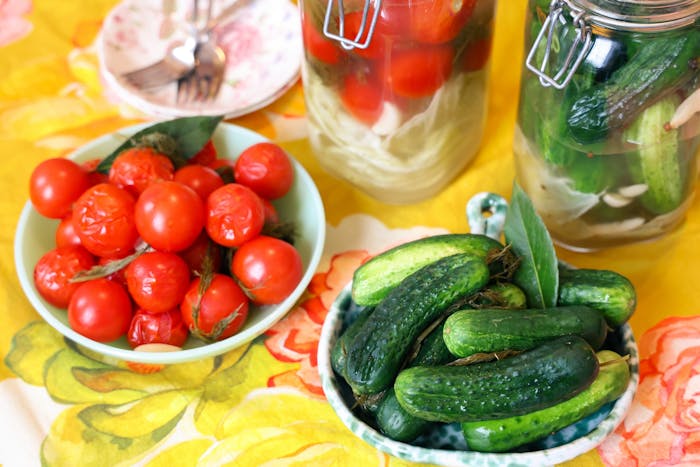Shared by Sasha and Marina Shor


Sasha Shor grew up surrounded by pickles — bright, briny, and ever-present at meals in her Jewish-Russian household. There were tart kirby cucumbers and juicy little tomatoes, which Sasha and her mother Marina shared with us in the Grandmas Tent at our 2,000 person picnic The Great Nosh. There was also vibrant magenta cabbage with beets, sweet-and-sour pickled watermelon and mushrooms — nearly every vegetable found their way into jars, preserved in saltwater with herbs and spices.
Sasha explains: “They were so common that we never even thought twice about them always being in the fridge in big jars or piled onto huge platters on the table next to all the salads and hot dishes — and, of course, as the most classic chaser for an icy shot of vodka.” When her family immigrated to the United States and landed in Nashville, Tennessee, they were surprised to find only vinegar-based pickles lining the grocery store shelves — too sharp, too sweet, and never quite right. So they returned to their roots and made their own.
Pickling was a way of life in Eastern Europe, Sasha adds, with entire cold cellars beneath apartment buildings dedicated to barrels of fermented vegetables. In Nashville, that legacy continued: Sasha’s grandfather grew cucumbers, dill, and tomatoes in his backyard garden and even collected small, sour crabapples from the trees for pickling — a practice they affectionately called “soaking.”
Sasha continues the tradition in New York in her Lower East Side kitchen, using produce from the Union Square Greenmarket. For her, it’s about more than taste — it’s about memory and identity. Each jar is a link to her heritage, her family, and the generations who pickled before her.
Read more about Sasha’s family in The Russian Picnic Tradition a Family Smuggled Out of the USSR and in our cookbook "The Jewish Holiday Table: A World of Recipes, Traditions & Stories to Celebrate All Year Long,” Plus, check out more recipes from The Great Nosh’s Grandmas Tent.
Make the brine: Pour the water into a pitcher or large jar, add the salt, and stir until it dissolves.
For the pickled cucumbers: layer the cabbage leaves, cucumbers, garlic, peppercorns, dill sprigs, and bay leaves in a 1-gallon jar. Do not push hard on the cucumbers or the skins may break.
For the pickled tomatoes: poke one or two holes in each tomato with a toothpick. In a separate 1-gallon jar, place a few cabbage leaf pieces at the bottom. Add the tomatoes, garlic, peppercorns, dill, and bay leaves in layers.
Pour the brine into both jars covering the contents completely with the liquid. Set a ramekin or small weight on top of the contents to keep everything submerged. Cover the jar with a cloth and secure with a rubber band or twine. Set the jar in a dark space at room temperature. (Note: Warm temperatures speed up fermentation, so if you’re making this recipe in the summer, find a cool room temperature place and check them after 2-3 days. Refrigerate them if you find they are souring quickly).
Check the pickles after 1 week to make sure everything is still submerged. At this point, taste one: If you like a milder flavor, you’ve got half-sours — you can refrigerate them now to stop fermentation.
If you prefer a stronger, tangier pickle, leave them out for another week to make full sours. Once the pickles are as sour as you like, refrigerate them.
The pickles will keep for at least a few weeks and up to a month in an airtight container in the refrigerator.